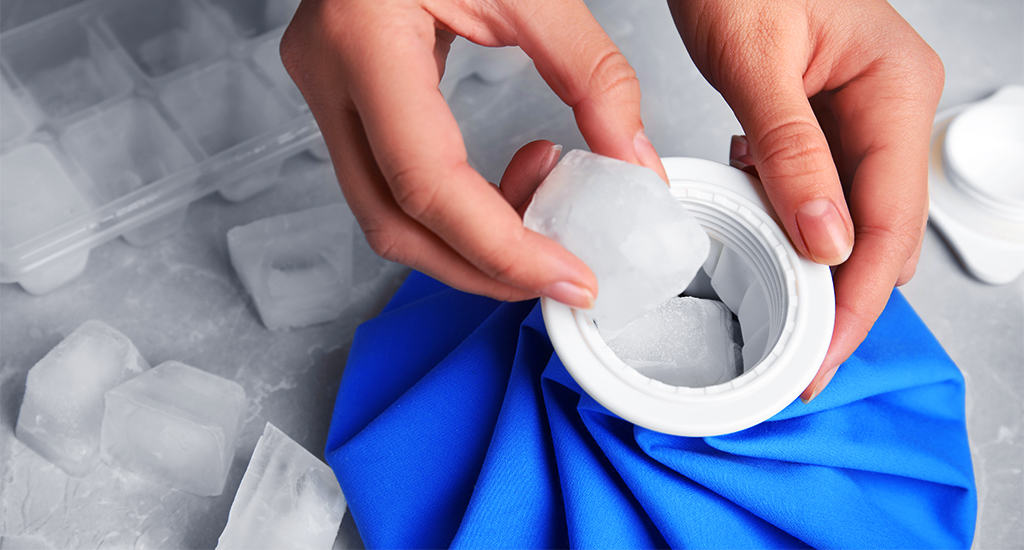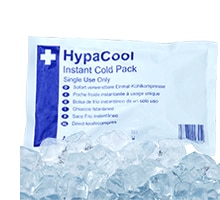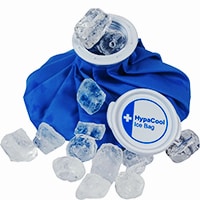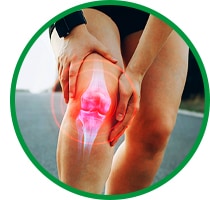
Cold therapy is a proven method of reducing pain and swelling when treating sprains or strains. While ice packs are one of the most common methods of applying it, cold therapy can be applied in many ways, including ice baths, cooling sprays and cold gel massages.
Cold therapy is the “I” or “Ice” component of the PRICE method of injury treatment, the NHS’s recommended method of treating minor muscle strains at home with first aid. While cold therapy is a very useful treatment method, it can be dangerous if implemented incorrectly. Knowing how to safely practice it is important.
How to properly use a cold pack or ice pack for cold therapy

1. Prepare your cold pack or ice pack
 Instant Cold Pack
Instant Cold Pack
Single use instant cold packs are typically made up of two plastic bags, one inside the other. The outer bag contains water, and the inner bag contains a mixture of chemicals. When the inner bag is ruptured and the chemicals are introduced to the water, a reaction occurs causing the bag to cool rapidly.
How to prepare an instant cold pack:
- Identify the inner bag of liquid and squeeze it as hard as you can to release its contents and begin the reaction.
- Shake the cold pack to quicken the reaction; the pack should become cold within a few seconds.
- Wrap the cold pack in a gel pack cover or a towel to prevent direct contact with the skin.
 Ice Pack
Ice Pack
A reusable ice bag is a convenient way to administer cold therapy quickly and repeatedly. As an alternative, ice packs can be made at home with relative ease by combining two parts water with one part rubbing alcohol in a plastic freezer bag and freezing it.How to prepare an ice pack:
- If you’re using a homemade ice pack, put it in the freezer for a minimum of one hour; if you are using a reusable ice bag, fill it with ice. (Crushed ice or smaller ice cubes are ideal as they conform more comfortably to the body)
- Wrap your ice pack in a towel to prevent direct contact with the skin.
2. Start cold therapy as quickly as possible
After ensuring that the affected area is protected from further injury as per the PRICE method, begin applying your ice pack as quickly as you can. If immediate treatment is impossible, aim to begin icing the injury within the first 48 hours.Apply your cold pack or ice pack to the site of the injury for 15 to 20 minutes at a time, leaving at least two hours between sessions. When your injury starts to feel numb, you should remove the cold or ice pack regardless of how long you have been icing the injury.
3. Employ other elements of the PRICE method

Cold therapy is most effective when it is used in conjunction with the other steps of the PRICE method of injury treatment. The steps of the PRICE method are:
- Protection: Ensure the affected area is protected from any further injury.
- Rest: Avoid activities involving the injured area that cause pain.
- Ice: Utilise cold therapy to soothe the affected area.
- Compression: Use conforming bandages during the daytime to limit swelling.
- Elevation: Keep the injured body part raised above the level of your heart when possible.
Commonly Asked Questions
How does ice help an injury?
When your body is injured, it begins to heal the damaged tissue by sending blood to site of the injury. This is called the inflammatory process. This rush of blood can cause you to experience swelling and pain at the site of the injury.While inflammation is a sign that your body has begun the process of healing your wound, ice can help to ease some of the discomfort that comes with it. Applying ice to the site of an injury causes blood vessels to narrow, reducing the amount of blood that reaches the area, keeping pain and swelling down.
Is using a cold pack better than using ice?
There are pros and cons to using either instant use cold packs or ice packs.Instant Cold Packs
| Pros | Cons |
|---|---|
| • Doesn't need to be refrigerated or frozen | • Single use |
| • Portable and lightweight | • Stays cold for a shorter period |
Instant use cold packs are most useful in emergency situations like sports injuries, or sprains and strains suffered while backpacking or hiking.
Ice Packs
| Pros | Cons |
|---|---|
| • Reusable | • Needs to be refrigerated or frozen before use |
| • Can be made at home or acquired inexpensively |
Ice packs are ideal for use at home, as part of the treatment of more long-term injuries.
How long should you apply ice or an ice pack?
Cold/ice packs should be applied to an injury for a maximum of 20 minutes at a time. Applying ice for any longer than this can cause damage to tissue. You can ice an injury several times a day, but it is recommended to wait two to three hours between sessions.20 minutes of cold therapy should be considered a guideline. If you’re not sure when you should stop icing an injury, a good rule of thumb is to remember the acronym CBAN:
- Cold: When you begin therapy, the ice should feel cold on the injury.
- Burn: Soon, the cold feeling will progress into a burning sensation. This feeling should only last for a few minutes.
- Ache: Next, you will feel a dull ache on the iced area.
- Numb: When the area becomes numb, it is time to stop cold therapy. This is true regardless of how long you have been icing the area.
Takeaway
Cold therapy is an effective way of reducing pain and swelling associated with sprain and strain injuries. You can use a cold or ice pack to soothe an injury a few times a day, but you should always leave 2 to 3 hours between sessions and avoid icing an injury for more than 20 minutes at a time. Always stop icing an injury when the affected area feels numb.Cold therapy works best as part of the PRICE method of injury treatment. Remember the steps:
- Protection
- Rest
- Ice
- Compression
- Elevation
Read our blog for more information on first aid, or contact us for further advice and information on our products.
About the author:
Jo Stokes is a writer, marketer and trained first aider at First Aid Online.
Find out more about Jo.
By Jo Stokes

